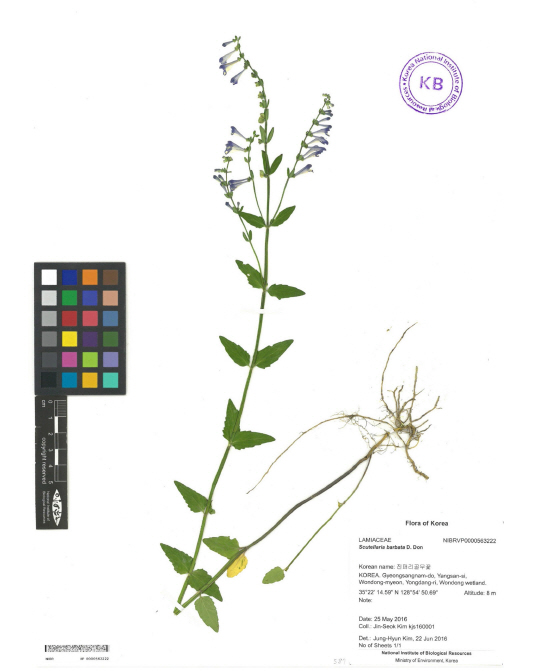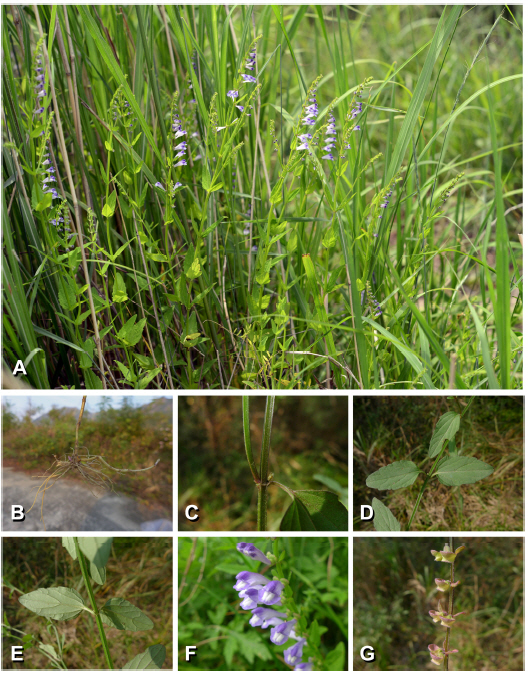/home/virtual/kjpt/journal//../xmls/kjpt-48-2-123.xml
LEE, KIM, LEE, KIM, and KIM: A new distribution record of Scutellaria barbata D. Don (Lamiaceae) and an erroneously identified Scutellaria in Korea
Abstract
Earlier taxonomic studies of Korean Scutellaria reported a new record of Scutellaria hastifolia L. in Korea based on three herbarium sheets. During a reexamination of these specimens, we found that the leaf characters of these specimens differ from those in the type specimen of S. hastifolia. Based on a literature survey and confirmation of the type specimen, the specimens identified as S. hastifolia thus far were a misidentification of S. barbata D. Don. S. hastifolia is clearly different from S. barbata by single conspicuous teeth on both sides of the leaf margins and larger leaves. In addition to the distribution sites of the three specimens used in the previous study, a distribution site of the S. barbata was newly found in the southern part of Korea. In this study, we report a new distribution of S. barbata in Korea, correct a previous report of S. hastifolia, describe the morphological characters of S. barbata, and suggest a taxonomic key to Korean Scutellaria including S. barbata.
Keywords: Lamiaceae, misidentification,
Scutellaria barbata
,
Scutellaria
, unrecorded species
Lamiaceae is the seventh largest family in flowering plants and contains about 236 genera and 7,200 species in the world ( Stevens et al., 2017). In Lamiaceae, Scutellaria is one of the largest genus containing about 360 taxa including an infraspecific level ( Paton, 1990). As annual/perennial herbs or subshrubs Scutellaria is characterized by the followings: calyx lips are entire and persistence, gynoecium has peg-like gynophore, the anterior stamens have unilocular thecae due to the abortion of the upper locule, etc. ( Paton, 1990; Kim and Lee, 1995). The current classification system based on a morphological revision of the genus contains seven sections placed in two subgenera, subgenus Scutellaria and subgenus Apelthanthus ( Paton, 1990) and 12 morphological species-groups have been suggested without taxonomic rank in the section Scutellaria, the largest section containing ca. 240 species in the genus. A bibliographical study of Korean Lamiaceae summarized that 26 genera including 65 taxa of Lamiaceae are distributed in Korea ( Suh et al., 2007). The taxonomic revision of Korean Scutellaria has reported that there are 17 taxa of Scutellaria in Korean peninsula: S. asperiflora Nakai, S. baicalensis Georgi, S. dependens Maxim., S. hastifolia L., S. indica L., S. indica var. alba S. T. Kim & S. T. Lee, S. indica var. coccinea S. T. Kim & S. T. Lee, S. indica var. parvifolia Makino, S. indica var. tsusimensis (Hara) Ohwi, S. insignis Nakai, S. moniliorrhiza Kom., S. pekinensis var. alpina (Nakai) Hara, S. pekinensis var. maxima S. T. Kim & S. T. Lee, S. pekinensis var. transitra (Makino) H. Hara ex H. W. Li, S. pekinensis var. ussuriensis (Regel) Hand.-Mazz., S. regeliana Nakai, and S. strigillosa Hemsl. ( Kim and Lee, 1995). After this study, two new records, S. orthocalyx Hand.-Mazz. ( Yang, 2004) and S. tuberifera C. Y. Wu & C. Chen ( Kim et al., 2011), in Korea have been added in the list of Scutellaria in Korea, although the distribution of S. orthocalyx have not been confirmed again after the original report ( Yang, 2004). The distribution of S. hastifolia in Korea have been newly reported in a previous study by Kim and Lee (1995) and assigned Korean name as Chang-gol-mu-kkot (창골무꽃), although it is based on only three herbarium specimens. While performing a comprehensive review of Korean Scutellaria, we found that the specimens of S. hastifolia used in previous taxonomic revision ( Kim and Lee, 1995) were conspicuously different in leaf shapes from its isotype specimen of S. hastifolia ( Royal Botanical Gardens, Kew, 2006). Furthermore, we recently found that the new natural distribution sites of this taxon in southern part of Korean peninsula and questioned its identification. After the literature survey of Scutellaria in the neighboring nations including China, Japan, and Russia, we concluded that these specimens are S. barbata D. Don., instead of S. hastifolia based on the character comparison of these specimen with original description and type specimen of S. barbata, especially leaf characters. In this study, we report new distribution site of S. barbata in Korea and corrected a previous report for S. hastifolia. We provided morphological description and assigned the Korean name of S. barbata. We also represented an updated key of the reviewed Korean Scutellaria including S. barbata.
Taxonomic Treatment
Scutellaria barbata
D. Don, Prodr. Fl. Nepal. 109, 1825 ( Figs. 1, 2).
Korean name: Chang-gol-mu-kkot (창골무꽃)
Herbs perennial, 35–50 cm tall. Stems erect, branched at inflorescences, glabrous or sparsely appressed pubescent upward. Leaves: petiole 1–5 mm long, sparsely pubescent; leaf blade narrow triangular-ovate to slightly hasti-form, 1.2–2.5 × 0.6–1.5 cm, apex acute, base broadly cuneate to subtruncate, margins obtusely shallow 3– or 4–dentate, subglabrous to sparsely appressed pubescent along veins. Inflorescences loose raceme, terminal; floral leaves similar to stem leaves, bracteoles linear, ca. 0.5 mm long; pedicels 1–2 mm long, puberulent. Flowers axillary; calyx 2–4 mm long, puberulent along veins outside, margins ciliate, to 4.5 mm long in fruit; scutellum ca. 1 mm long, to 2 mm long in fruit; corolla purple blue, 1.2– 1.7 cm long, pubescent outside, sparsely pilose on throat inside; tube 30–60° angled at base, ca. 1.5 mm wide at middle, gradually dilated to ca. 3.5 mm wide at throat; upper lip semicircular, ca. 1.5 mm long; middle lobe of lower lip trapeziform, entire; lateral lobes triangular-ovate, apex acute. Nutlets brown, oblate, 1–1.5 mm in diam., papillate.
Flowering: May to July.
Distribution: Korea, China, India, Japan, Laos, Myanmar, Nepal, Taiwan, Thailand, Vietnam.
Type: in the Herbarium of Nepal (not seen). The type specimen of the synonym Scutellaria komarovii H. Lév. & Vaniot is in Royal Bonatic Garden of Edinburgh.
Specimens observed: KOREA. Gyeonggi-do: Yangpyeong -gun, Yangseo-myeon, Yangsu-ri, 5 Jun 1986, H. J. Jung s. n. (SWU). Gyeongsangbuk-do: Biseulsan Mt., 12 Jul 1958, s. n. (SKK)*; Uiseong-gun, Anpyeong-myeon, Majeon-ri, 18 Jul 2017, Won-Jung Lee et al. US171318 (KB) #. Gyeongsangnamdo: Gimhae-si, Hallim-myeon, Toerae-ri, 15 Oct 2017, J.S. Kim kjs17092 (KB) #; Haman-gun, Gaya-eup, Sanseo-ri, 13 Sep 2017, J.S. Kim kjs17052 (KB) #; Yangsan-si, Wondong-myeon, Yongdang-ri, Wondong Wetland, 3 Jun 2000, G. Y. Chung and H. J. Kwon s. n. (KB) #; 25 May 2016, J.S. Kim kjs160001, 160002, 160003 (KB) #. Seoul: Dongjak-gu, Dongjak-dong, 13 Jun 1972, C. H. Han s. n. (EWU)*; 1 Jul 1932, s. n. (SNU)* Note: *Three specimens used in previous report on S. hastifolia ( Kim and Lee, 1995); #New distribution sites confirmed in this study.
Key to Korean Scutellaria taxa
1. Rhizomes enlarged up to 3 cm in diam.; cross section of stem obtuse-square or rounded; leaves ovate-lanceolate or lanceolate ·············································· S. baicalensis 황금 1. Rhizomes not enlarged, less than 7 mm in diam.; cross section of stem swollen-edged square; leaves not ovate-lanceolate or lanceolate.
2. Flowers in axillary racemes.
11. Rhizomes with long leafless stolons at nodes; tubers 5–7 mm in diam. present at the end of stolons ······ ·········································· S. tuberifera 제주골무꽃 11. Rhizomes with stolons; no tubers.
12. Base angle of corolla tube less than 10°; corolla less than 8 mm long, upper lip shorter than lower lip ···························· S. dependens 애기골무꽃 12. Base angle of corolla tube higher than 45°; corolla longer than 15 mm long, length of upper lip similar to lower lip.
13. Rhizomes moniliform, with enlarged tuber-like internodes; stems glabrous; leaves narrow ovate ············· S. moniliorrhiza 구슬골무꽃 13. Rhizomes not moniliform; stems pubescent; leaves linear, lanceolate, ovate or elliptic.
14. Leaves linear to lanceolate, apex acute, margins shallow-serrate ························ ····················· S. regeliana 가는골무꽃 14. Leaves ovate to elliptic, apex obtuse, margins crenate ·· S. strigillosa 참골무꽃
Taxonomic Notes: Although S. hastifolia has been reported as a new distribution record in Korea in a previous study ( Kim and Lee, 1995), we concluded that this was a misidentification of S. barbata based on reexamination of the herbarium sheets used in the previous study. S. hastifolia is different from S. barbata by the notation of single conspicuous teeth on the base of leaf margins and larger sized leaves. Notably, the leaf shape of S. barbata is also similar to that of S. dependens. However, it is clearly distinguished from S. dependens by having the following characters: the spike-raceme is placed at the terminal of stem instead of leaf axil, the base of the corolla is curved instead of straight, and the color of corolla is cyanic instead of white ( Kim and Lee, 1995).
Li and Hedge (1994) have mentioned in the flora of China that S. barbata is distributed in Korea in addition to China and Japan, and that their habitat is specific to the margins of rice paddies, stream sides, and wet grasslands. Im (1999) also have reported the distribution of this species in Korea, but both reports did not include distribution sites in Korea or information of the voucher specimen. As a medicinal plant called ‘Banzhi- lian (半枝蓮),’ this species has been cultivated in China and rarely in Korea. Therefore, the natural distribution of this species in Korea has been debated.
One of new natural distribution site of S. barbata found in this study is the Wondong wetland located in Wondong-myeon, Yangsan-si in Gyeongsangnam-do. It is noted that the two populations containing ca. 10 and 20 individuals, respectively, are found in open place of the wetland. They grow together with Galium dahuricum var. tokyoense (Makino) Cufod., Agropyron ciliare (Trin.) Franch. and the dominant species of this area is Phragmites communis Trin. Based on a survey of the adjacent area, we concluded that they are natural populations rather than naturalized populations by escaped individuals from a cultivated area, because it is noted that the original habitat described in other countries ( Li and Hedge, 1994) is similar to that of the new distribution site in Korea and cultivation of this species in Korea is very rare. We suggest ‘Chang-gol-mu-kkot (창골무 꽃)’ as the Korean name of S. barbata since this species has long been misidentified as S. hasfolia in Korea with same Korean name.
ACKNOWLEDGMENTS
This work was supported by the Sungshin University Research Grant of 2016.
Fig. 1.
A specimen of Scutellria barbata D. Don (NIBRVP0000563222) collected from new distribution site reported in this study (Wondong wetland, Gyeongsangnam-do, Korea). 
Fig. 2.
Photographs of Scutellria barbata D. Don. A. Habit. B. Rhizome. C. Stem. D. Leaf (adaxial surface). E. Leaf (abaxial surface). F. Flower. G. Nutlets. 
Literature Cited
Im, RJ. 1999. Flora Coreana, Vol. 6. Science and Technology Publishing House, Pyongyang. 172-181 (in Korean).
Kim, C-S. Kim, S-Y and Byun, G-O. 2011. A new record for Korean flora: Scutellaria tuberifera C. Y. Wu & C. Chen (Lamiaceae). Korean Journal of Plant Taxonomy 41: 249-252.   Kim, S and Lee, S. 1995. Taxonomy of the genus Scutellaria (Lamiaceae) in Korea. Korean Journal of Plant Taxonomy 25: 71-102 (in Korean).   Li, X and Hedge, IC. 1994.
Scutellaria L. Flora of China, Vol. 17. Verbenaceae through Solanaceae. Wu, ZY. Raven, PH (eds.), Science Press, Beijing and Missouri Botanical Garden Press, St Louis, MO. 75-103.
Paton, A. 1990. A global taxonomic investigation of Scutellaria (Labiatae). Kew Bulletin 45: 399-450.  Suh, YB. 2007.
Scutellaria L. The Genera of Vascular Plants of Korea. Park, C-W (ed.), Academy Publishing Co, Seoul. 819-822 (in Korean).
Suh, YB. Hong, SP and Park, SJ. 2007. Lamiaceae Martinov. The Genera of Vascular Plants of Korea. Park, C-W (ed.), Academy Publishing Co, Seoul. 815-817.
Yang, YH. 2004. One unrecorded species from: Scutellaris orthocalyx Hand.-Mazz. Korean Journal of Plant Resources 17: 41-42 (in Korean).
|
|













